run flat INFINITI Q70 HYBRID 2018 Warranty Information Booklet
[x] Cancel search | Manufacturer: INFINITI, Model Year: 2018, Model line: Q70 HYBRID, Model: INFINITI Q70 HYBRID 2018Pages: 60, PDF Size: 0.27 MB
Page 29 of 60
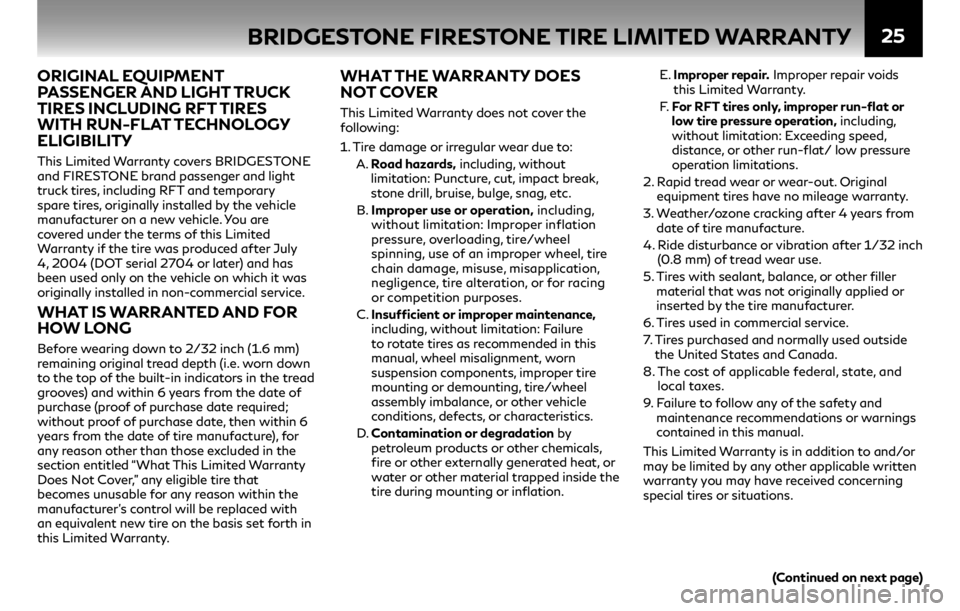
25BRIDGESTONE FIRESTONE TIRE LIMITED WARRANTY
ORIGINAL EQUIPMENT
PASSENGER AND LIGHT TRUCK
TIRES INCLUDING RFT TIRES
WITH RUN-FLAT TECHNOLOGY
ELIGIBILITY
This Limited Warranty covers BRIDGESTONE
and FIRESTONE brand passenger and light
truck tires, including RFT and temporary
spare tires, originally installed by the vehicle
manufacturer on a new vehicle. You are
covered under the terms of this Limited
Warranty if the tire was produced after July
4, 2004 (DOT serial 2704 or later) and has
been used only on the vehicle on which it was
originally installed in non-commercial service.
WHAT IS WARRANTED AND FOR
HOW LONG
Before wearing down to 2/32 inch (1.6 mm)
remaining original tread depth (i.e. worn down
to the top of the built-in indicators in the tread
grooves) and within 6 years from the date of
purchase (proof of purchase date required;
without proof of purchase date, then within 6
years from the date of tire manufacture), for
any reason other than those excluded in the
section entitled “What This Limited Warranty
Does Not Cover,” any eligible tire that
becomes unusable for any reason within the
manufacturer’s control will be replaced with
an equivalent new tire on the basis set forth in
this Limited Warranty.
WHAT THE WARRANTY DOES
NOT COVER
This Limited Warranty does not cover the
following:
1. Tire damage or irregular wear due to:
A. Road hazards, including, without
limitation: Puncture, cut, impact break,
stone drill, bruise, bulge, snag, etc.
B. Improper use or operation, including,
without limitation: Improper inflation
pressure, overloading, tire/wheel
spinning, use of an improper wheel, tire
chain damage, misuse, misapplication,
negligence, tire alteration, or for racing
or competition purposes.
C. Insufficient or improper maintenance,
including, without limitation: Failure
to rotate tires as recommended in this
manual, wheel misalignment, worn
suspension components, improper tire
mounting or demounting, tire/wheel
assembly imbalance, or other vehicle
conditions, defects, or characteristics.
D. Contamination or degradation by
petroleum products or other chemicals,
fire or other externally generated heat, or
water or other material trapped inside the
tire during mounting or inflation. E.
Improper repair. Improper repair voids
this Limited Warranty.
F. For RFT tires only, improper run-flat or
low tire pressure operation, including,
without limitation: Exceeding speed,
distance, or other run-flat/ low pressure
operation limitations.
2. Rapid tread wear or wear-out. Original equipment tires have no mileage warranty.
3. Weather/ozone cracking after 4 years from
date of tire manufacture.
4. Ride disturbance or vibration after 1/32 inch
(0.8 mm) of tread wear use.
5. Tires with sealant, balance, or other filler
material that was not originally applied or
inserted by the tire manufacturer.
6. Tires used in commercial service.
7. Tires purchased and normally used outside
the United States and Canada.
8. The cost of applicable federal, state, and
local taxes.
9. Failure to follow any of the safety and
maintenance recommendations or warnings
contained in this manual.
This Limited Warranty is in addition to and/or
may be limited by any other applicable written
warranty you may have received concerning
special tires or situations.
(Continued on next page)
Page 35 of 60
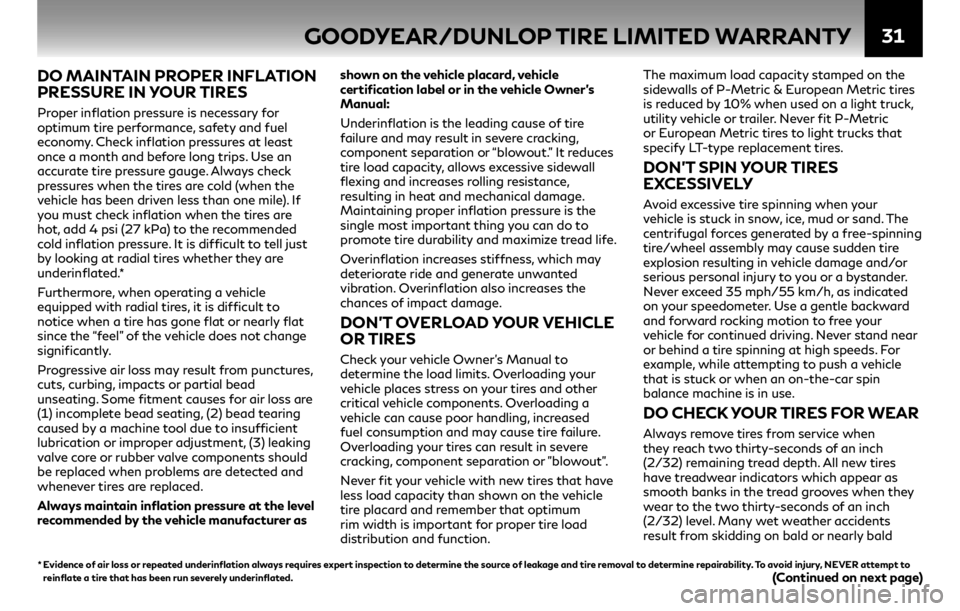
31
DO MAINTAIN PROPER INFLATION
PRESSURE IN YOUR TIRES
Proper inflation pressure is necessary for
optimum tire performance, safety and fuel
economy. Check inflation pressures at least
once a month and before long trips. Use an
accurate tire pressure gauge. Always check
pressures when the tires are cold (when the
vehicle has been driven less than one mile). If
you must check inflation when the tires are
hot, add 4 psi (27 kPa) to the recommended
cold inflation pressure. It is difficult to tell just
by looking at radial tires whether they are
underinflated.*
Furthermore, when operating a vehicle
equipped with radial tires, it is difficult to
notice when a tire has gone flat or nearly flat
since the “feel” of the vehicle does not change
significantly.
Progressive air loss may result from punctures,
cuts, curbing, impacts or partial bead
unseating. Some fitment causes for air loss are
(1) incomplete bead seating, (2) bead tearing
caused by a machine tool due to insufficient
lubrication or improper adjustment, (3) leaking
valve core or rubber valve components should
be replaced when problems are detected and
whenever tires are replaced.
Always maintain inflation pressure at the level
recommended by the vehicle manufacturer as shown on the vehicle placard, vehicle
certification label or in the vehicle Owner’s
Manual:
Underinflation is the leading cause of tire
failure and may result in severe cracking,
component separation or “blowout.” It reduces
tire load capacity, allows excessive sidewall
flexing and increases rolling resistance,
resulting in heat and mechanical damage.
Maintaining proper inflation pressure is the
single most important thing you can do to
promote tire durability and maximize tread life.
Overinflation increases stiffness, which may
deteriorate ride and generate unwanted
vibration. Overinflation also increases the
chances of impact damage.
DON’T OVERLOAD YOUR VEHICLE
OR TIRES
Check your vehicle Owner’s Manual to
determine the load limits. Overloading your
vehicle places stress on your tires and other
critical vehicle components. Overloading a
vehicle can cause poor handling, increased
fuel consumption and may cause tire failure.
Overloading your tires can result in severe
cracking, component separation or "blowout".
Never fit your vehicle with new tires that have
less load capacity than shown on the vehicle
tire placard and remember that optimum
rim width is important for proper tire load
distribution and function. The maximum load capacity stamped on the
sidewalls of P-Metric & European Metric tires
is reduced by 10% when used on a light truck,
utility vehicle or trailer. Never fit P-Metric
or European Metric tires to light trucks that
specify LT-type replacement tires.
DON’T SPIN YOUR TIRES
EXCESSIVELY
Avoid excessive tire spinning when your
vehicle is stuck in snow, ice, mud or sand. The
centrifugal forces generated by a free-spinning
tire/wheel assembly may cause sudden tire
explosion resulting in vehicle damage and/or
serious personal injury to you or a bystander.
Never exceed 35 mph/55 km/h, as indicated
on your speedometer. Use a gentle backward
and forward rocking motion to free your
vehicle for continued driving. Never stand near
or behind a tire spinning at high speeds. For
example, while attempting to push a vehicle
that is stuck or when an on-the-car spin
balance machine is in use.
DO CHECK YOUR TIRES FOR WEAR
Always remove tires from service when
they reach two thirty-seconds of an inch
(2/32) remaining tread depth. All new tires
have treadwear indicators which appear as
smooth banks in the tread grooves when they
wear to the two thirty-seconds of an inch
(2/32) level. Many wet weather accidents
result from skidding on bald or nearly bald
GOODYEAR/DUNLOP TIRE LIMITED WARRANTY
(Continued on next page)* Evidence of air loss or repeated underinflation always requires expert inspection to determine the source of leakage and tire removal to determine repairability. To avoid injury, NEVER attempt to
reinflate a tire that has been run severely underinflated.
Page 38 of 60
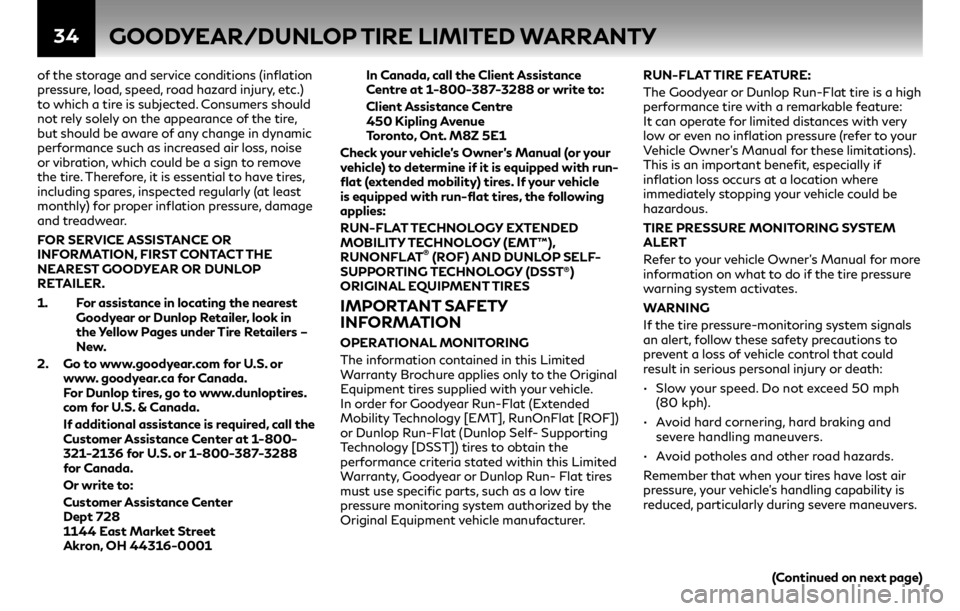
34
of the storage and service conditions (inflation
pressure, load, speed, road hazard injury, etc.)
to which a tire is subjected. Consumers should
not rely solely on the appearance of the tire,
but should be aware of any change in dynamic
performance such as increased air loss, noise
or vibration, which could be a sign to remove
the tire. Therefore, it is essential to have tires,
including spares, inspected regularly (at least
monthly) for proper inflation pressure, damage
and treadwear.
FOR SERVICE ASSISTANCE OR
INFORMATION, FIRST CONTACT THE
NEAREST GOODYEAR OR DUNLOP
RETAILER.
1. For assistance in locating the nearest Goodyear or Dunlop Retailer, look in
the Yellow Pages under Tire Retailers –
New.
2. Go to www.goodyear.com for U.S. or www. goodyear.ca for Canada.
For Dunlop tires, go to www.dunloptires.
com for U.S. & Canada.
If additional assistance is required, call the Customer Assistance Center at 1-800-
321-2136 for U.S. or 1-800-387-3288
for Canada.
Or write to:
Customer Assistance Center Dept 728
1144 East Market Street
Akron, OH 44316-0001 In Canada, call the Client Assistance
Centre at 1-800-387-3288 or write to:
Client Assistance Centre 450 Kipling Avenue
Toronto, Ont. M8Z 5E1
Check your vehicle’s Owner’s Manual (or your
vehicle) to determine if it is equipped with run-
flat (extended mobility) tires. If your vehicle
is equipped with run-flat tires, the following
applies:
RUN-FLAT TECHNOLOGY EXTENDED
MOBILITY TECHNOLOGY (EMT™),
RUNONFLAT
® (ROF) AND DUNLOP SELF-
SUPPORTING TECHNOLOGY (DSST®)
ORIGINAL EQUIPMENT TIRES
IMPORTANT SAFETY
INFORMATION
OPERATIONAL MONITORING
The information contained in this Limited
Warranty Brochure applies only to the Original
Equipment tires supplied with your vehicle.
In order for Goodyear Run-Flat (Extended
Mobility Technology [EMT], RunOnFlat [ROF])
or Dunlop Run-Flat (Dunlop Self- Supporting
Technology [DSST]) tires to obtain the
performance criteria stated within this Limited
Warranty, Goodyear or Dunlop Run- Flat tires
must use specific parts, such as a low tire
pressure monitoring system authorized by the
Original Equipment vehicle manufacturer. RUN-FLAT TIRE FEATURE:
The Goodyear or Dunlop Run-Flat tire is a high
performance tire with a remarkable feature:
It can operate for limited distances with very
low or even no inflation pressure (refer to your
Vehicle Owner’s Manual for these limitations).
This is an important benefit, especially if
inflation loss occurs at a location where
immediately stopping your vehicle could be
hazardous.
TIRE PRESSURE MONITORING SYSTEM
ALERT
Refer to your vehicle Owner’s Manual for more
information on what to do if the tire pressure
warning system activates.
WARNING
If the tire pressure-monitoring system signals
an alert, follow these safety precautions to
prevent a loss of vehicle control that could
result in serious personal injury or death:
• Slow your speed. Do not exceed 50 mph
(80 kph).
• Avoid hard cornering, hard braking and severe handling maneuvers.
• Avoid potholes and other road hazards.
Remember that when your tires have lost air
pressure, your vehicle’s handling capability is
reduced, particularly during severe maneuvers.
GOODYEAR/DUNLOP TIRE LIMITED WARRANTY
(Continued on next page)
Page 39 of 60
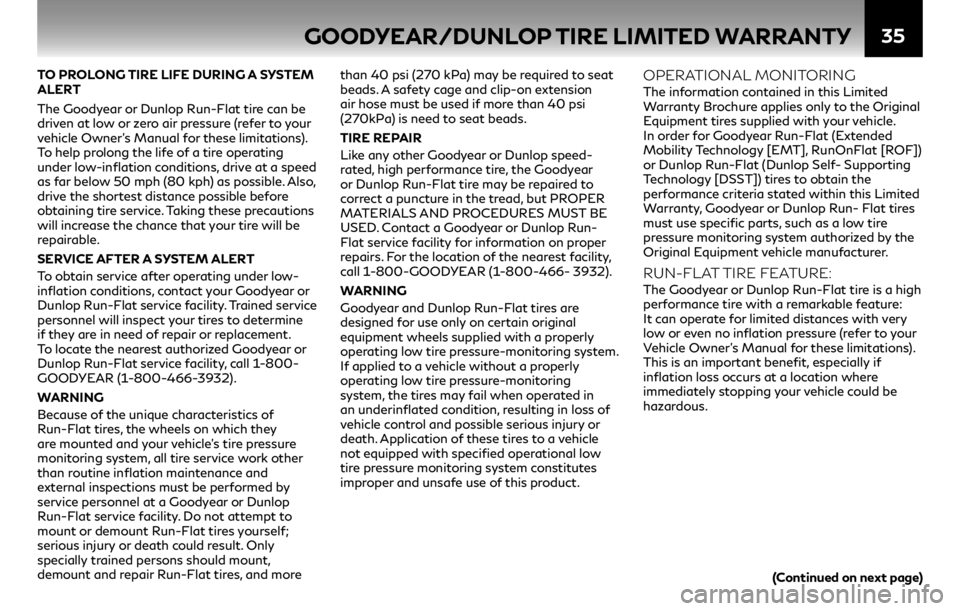
35
TO PROLONG TIRE LIFE DURING A SYSTEM
ALERT
The Goodyear or Dunlop Run-Flat tire can be
driven at low or zero air pressure (refer to your
vehicle Owner’s Manual for these limitations).
To help prolong the life of a tire operating
under low-inflation conditions, drive at a speed
as far below 50 mph (80 kph) as possible. Also,
drive the shortest distance possible before
obtaining tire service. Taking these precautions
will increase the chance that your tire will be
repairable.
SERVICE AFTER A SYSTEM ALERT
To obtain service after operating under low-
inflation conditions, contact your Goodyear or
Dunlop Run-Flat service facility. Trained service
personnel will inspect your tires to determine
if they are in need of repair or replacement.
To locate the nearest authorized Goodyear or
Dunlop Run-Flat service facility, call 1-800-
GOODYEAR (1-800-466-3932).
WARNING
Because of the unique characteristics of
Run-Flat tires, the wheels on which they
are mounted and your vehicle’s tire pressure
monitoring system, all tire service work other
than routine inflation maintenance and
external inspections must be performed by
service personnel at a Goodyear or Dunlop
Run-Flat service facility. Do not attempt to
mount or demount Run-Flat tires yourself;
serious injury or death could result. Only
specially trained persons should mount,
demount and repair Run-Flat tires, and more than 40 psi (270 kPa) may be required to seat
beads. A safety cage and clip-on extension
air hose must be used if more than 40 psi
(270kPa) is need to seat beads.
TIRE REPAIR
Like any other Goodyear or Dunlop speed-
rated, high performance tire, the Goodyear
or Dunlop Run-Flat tire may be repaired to
correct a puncture in the tread, but PROPER
MATERIALS AND PROCEDURES MUST BE
USED. Contact a Goodyear or Dunlop Run-
Flat service facility for information on proper
repairs. For the location of the nearest facility,
call 1-800-GOODYEAR (1-800-466- 3932).
WARNING
Goodyear and Dunlop Run-Flat tires are
designed for use only on certain original
equipment wheels supplied with a properly
operating low tire pressure-monitoring system.
If applied to a vehicle without a properly
operating low tire pressure-monitoring
system, the tires may fail when operated in
an underinflated condition, resulting in loss of
vehicle control and possible serious injury or
death. Application of these tires to a vehicle
not equipped with specified operational low
tire pressure monitoring system constitutes
improper and unsafe use of this product.OPERATIONAL MONITORINGThe information contained in this Limited
Warranty Brochure applies only to the Original
Equipment tires supplied with your vehicle.
In order for Goodyear Run-Flat (Extended
Mobility Technology [EMT], RunOnFlat [ROF])
or Dunlop Run-Flat (Dunlop Self- Supporting
Technology [DSST]) tires to obtain the
performance criteria stated within this Limited
Warranty, Goodyear or Dunlop Run- Flat tires
must use specific parts, such as a low tire
pressure monitoring system authorized by the
Original Equipment vehicle manufacturer.
RUN-FLAT TIRE FEATURE:The Goodyear or Dunlop Run-Flat tire is a high
performance tire with a remarkable feature:
It can operate for limited distances with very
low or even no inflation pressure (refer to your
Vehicle Owner’s Manual for these limitations).
This is an important benefit, especially if
inflation loss occurs at a location where
immediately stopping your vehicle could be
hazardous.
GOODYEAR/DUNLOP TIRE LIMITED WARRANTY
(Continued on next page)
Page 40 of 60

36
TIRE PRESSURE MONITORING
SYSTEM ALERT
Refer to your vehicle Owner’s Manual for more
information on what to do if the tire pressure
warning system activates.
WARNING
If the tire pressure-monitoring system signals
an alert, follow these safety precautions to
prevent a loss of vehicle control that could
result in serious personal injury or death:
• Slow your speed. Do not exceed 50 mph (80 kph).
• Avoid hard cornering, hard braking and severe handling maneuvers.
• Avoid potholes and other road hazards
Remember that when your tires have lost air
pressure, your vehicle’s handling capability is
reduced, particularly during severe maneuvers.
TO PROLONG TIRE LIFE DURING A
SYSTEM ALERT
The Goodyear or Dunlop Run-Flat tire can be
driven at low or zero air pressure (refer to your
vehicle Owner’s Manual for these limitations).
To help prolong the life of a tire operating
under low-inflation conditions, drive at a speed
as far below 50 mph (80 kph) as possible. Also,
drive the shortest distance possible before
obtaining tire service. Taking these precautions
will increase the chance that your tire will be
repairable.
SERVICE AFTER A SYSTEM ALERT
To obtain service after operating under low-
inflation conditions, contact your Goodyear or
Dunlop Run-Flat service facility. Trained service
personnel will inspect your tires to determine
if they are in need of repair or replacement.
To locate the nearest authorized Goodyear or
Dunlop Run-Flat service facility, call 1-800-
GOODYEAR (1-800-466-3932).
WARNING
Because of the unique characteristics of
Run-Flat tires, the wheels on which they
are mounted and your vehicle’s tire pressure
monitoring system, all tire service work other
than routine inflation maintenance and
external inspections must be performed by
service personnel at a Goodyear or Dunlop
Run-Flat service facility. Do not attempt to
mount or demount Run-Flat tires yourself;
serious injury or death could result. Only
specially trained persons should mount,
demount and repair Run-Flat tires, and more
than 40 psi (270 kPa) may be required to seat
beads. A safety cage and clip-on extension
air hose must be used if more than 40 psi
(270kPa) is needed to seat beads.
TIRE REPAIRLike any other Goodyear or Dunlop speed-
rated, high performance tire, the Goodyear
or Dunlop Run-Flat tire may be repaired to
correct a puncture in the tread, but PROPER
MATERIALS AND PROCEDURES MUST BE
USED. Contact a Goodyear or Dunlop Run-
Flat service facility for information on proper
repairs. For the location of the nearest facility,
call 1-800-GOODYEAR (1-800-466- 3932).
WARNING
Goodyear and Dunlop Run-Flat tires are
designed for use only on certain original
equipment wheels supplied with a properly
operating low tire pressure-monitoring system.
If applied to a vehicle without a properly
operating low tire pressure-monitoring
system, the tires may fail when operated in
an underinflated condition, resulting in loss of
vehicle control and possible serious injury or
death. Application of these tires to a vehicle
not equipped with specified operational low
tire pressure-monitoring system constitutes
improper and unsafe use of this product.
GOODYEAR/DUNLOP TIRE LIMITED WARRANTY
Page 49 of 60
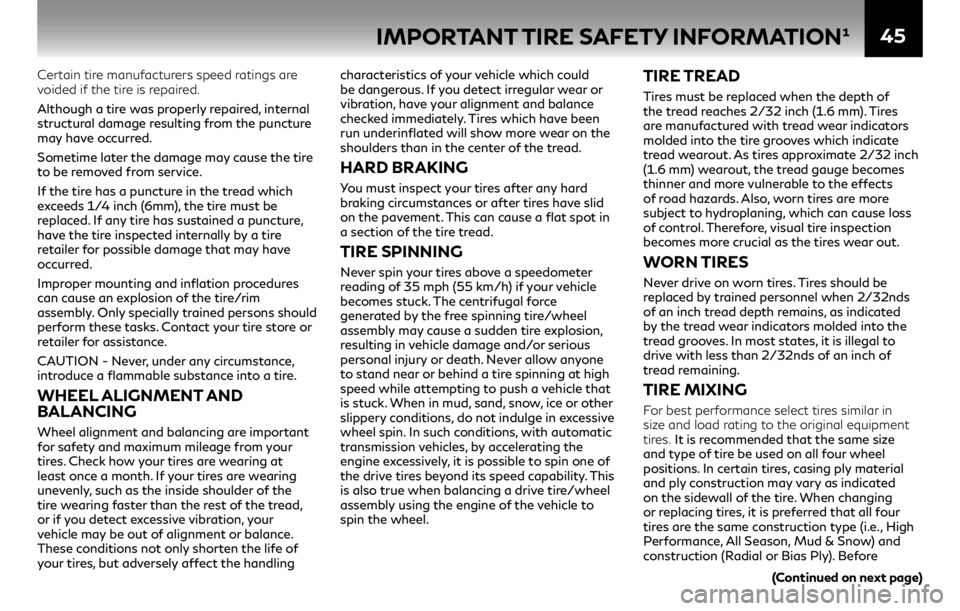
45
Certain tire manufacturers speed ratings are
voided if the tire is repaired.
Although a tire was properly repaired, internal
structural damage resulting from the puncture
may have occurred.
Sometime later the damage may cause the tire
to be removed from service.
If the tire has a puncture in the tread which
exceeds 1/4 inch (6mm), the tire must be
replaced. If any tire has sustained a puncture,
have the tire inspected internally by a tire
retailer for possible damage that may have
occurred.
Improper mounting and inflation procedures
can cause an explosion of the tire/rim
assembly. Only specially trained persons should
perform these tasks. Contact your tire store or
retailer for assistance.
CAUTION - Never, under any circumstance,
introduce a flammable substance into a tire.
WHEEL ALIGNMENT AND
BALANCING
Wheel alignment and balancing are important
for safety and maximum mileage from your
tires. Check how your tires are wearing at
least once a month. If your tires are wearing
unevenly, such as the inside shoulder of the
tire wearing faster than the rest of the tread,
or if you detect excessive vibration, your
vehicle may be out of alignment or balance.
These conditions not only shorten the life of
your tires, but adversely affect the handling characteristics of your vehicle which could
be dangerous. If you detect irregular wear or
vibration, have your alignment and balance
checked immediately. Tires which have been
run underinflated will show more wear on the
shoulders than in the center of the tread.
HARD BRAKING
You must inspect your tires after any hard
braking circumstances or after tires have slid
on the pavement. This can cause a flat spot in
a section of the tire tread.
TIRE SPINNING
Never spin your tires above a speedometer
reading of 35 mph (55 km/h) if your vehicle
becomes stuck. The centrifugal force
generated by the free spinning tire/wheel
assembly may cause a sudden tire explosion,
resulting in vehicle damage and/or serious
personal injury or death. Never allow anyone
to stand near or behind a tire spinning at high
speed while attempting to push a vehicle that
is stuck. When in mud, sand, snow, ice or other
slippery conditions, do not indulge in excessive
wheel spin. In such conditions, with automatic
transmission vehicles, by accelerating the
engine excessively, it is possible to spin one of
the drive tires beyond its speed capability. This
is also true when balancing a drive tire/wheel
assembly using the engine of the vehicle to
spin the wheel.
TIRE TREAD
Tires must be replaced when the depth of
the tread reaches 2/32 inch (1.6 mm). Tires
are manufactured with tread wear indicators
molded into the tire grooves which indicate
tread wearout. As tires approximate 2/32 inch
(1.6 mm) wearout, the tread gauge becomes
thinner and more vulnerable to the effects
of road hazards. Also, worn tires are more
subject to hydroplaning, which can cause loss
of control. Therefore, visual tire inspection
becomes more crucial as the tires wear out.
WORN TIRES
Never drive on worn tires. Tires should be
replaced by trained personnel when 2/32nds
of an inch tread depth remains, as indicated
by the tread wear indicators molded into the
tread grooves. In most states, it is illegal to
drive with less than 2/32nds of an inch of
tread remaining.
TIRE MIXING
For best performance select tires similar in
size and load rating to the original equipment
tires. It is recommended that the same size
and type of tire be used on all four wheel
positions. In certain tires, casing ply material
and ply construction may vary as indicated
on the sidewall of the tire. When changing
or replacing tires, it is preferred that all four
tires are the same construction type (i.e., High
Performance, All Season, Mud & Snow) and
construction (Radial or Bias Ply). Before
IMPORTANT TIRE SAFETY INFORMATION¹
(Continued on next page)
Page 50 of 60
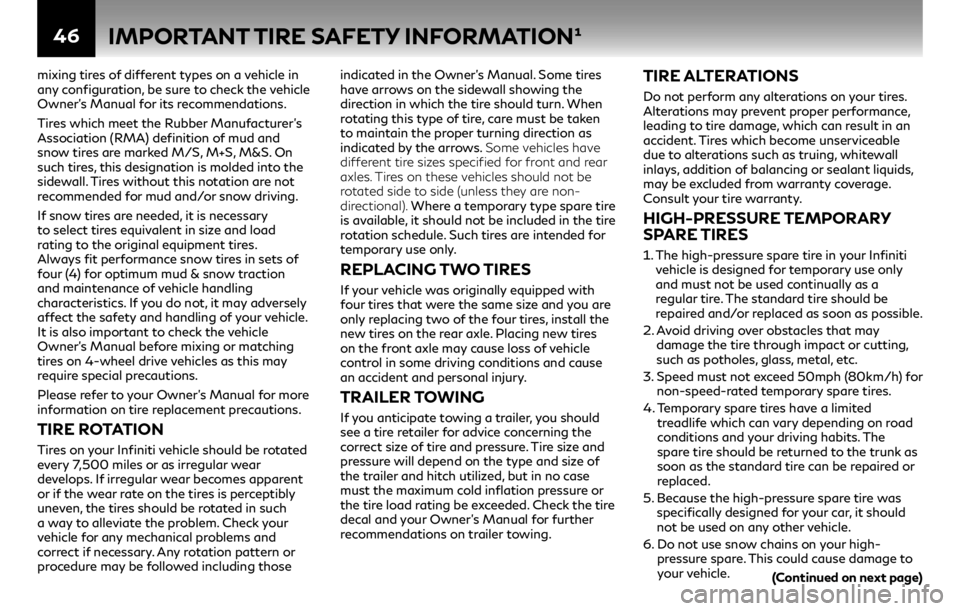
46
mixing tires of different types on a vehicle in
any configuration, be sure to check the vehicle
Owner’s Manual for its recommendations.
Tires which meet the Rubber Manufacturer’s
Association (RMA) definition of mud and
snow tires are marked M/S, M+S, M&S. On
such tires, this designation is molded into the
sidewall. Tires without this notation are not
recommended for mud and/or snow driving.
If snow tires are needed, it is necessary
to select tires equivalent in size and load
rating to the original equipment tires.
Always fit performance snow tires in sets of
four (4) for optimum mud & snow traction
and maintenance of vehicle handling
characteristics. If you do not, it may adversely
affect the safety and handling of your vehicle.
It is also important to check the vehicle
Owner’s Manual before mixing or matching
tires on 4-wheel drive vehicles as this may
require special precautions.
Please refer to your Owner’s Manual for more
information on tire replacement precautions.
TIRE ROTATION
Tires on your Infiniti vehicle should be rotated
every 7,500 miles or as irregular wear
develops. If irregular wear becomes apparent
or if the wear rate on the tires is perceptibly
uneven, the tires should be rotated in such
a way to alleviate the problem. Check your
vehicle for any mechanical problems and
correct if necessary. Any rotation pattern or
procedure may be followed including those indicated in the Owner’s Manual. Some tires
have arrows on the sidewall showing the
direction in which the tire should turn. When
rotating this type of tire, care must be taken
to maintain the proper turning direction as
indicated by the arrows. Some vehicles have
different tire sizes specified for front and rear
axles. Tires on these vehicles should not be
rotated side to side (unless they are non-
directional). Where a temporary type spare tire
is available, it should not be included in the tire
rotation schedule. Such tires are intended for
temporary use only.
REPLACING TWO TIRES
If your vehicle was originally equipped with
four tires that were the same size and you are
only replacing two of the four tires, install the
new tires on the rear axle. Placing new tires
on the front axle may cause loss of vehicle
control in some driving conditions and cause
an accident and personal injury.
TRAILER TOWING
If you anticipate towing a trailer, you should
see a tire retailer for advice concerning the
correct size of tire and pressure. Tire size and
pressure will depend on the type and size of
the trailer and hitch utilized, but in no case
must the maximum cold inflation pressure or
the tire load rating be exceeded. Check the tire
decal and your Owner’s Manual for further
recommendations on trailer towing.
TIRE ALTERATIONS
Do not perform any alterations on your tires.
Alterations may prevent proper performance,
leading to tire damage, which can result in an
accident. Tires which become unserviceable
due to alterations such as truing, whitewall
inlays, addition of balancing or sealant liquids,
may be excluded from warranty coverage.
Consult your tire warranty.
HIGH-PRESSURE TEMPORARY
SPARE TIRES
1.
The high-pressure spare tire in your Infiniti
vehicle is designed for temporary use only
and must not be used continually as a
regular tire. The standard tire should be
repaired and/or replaced as soon as possible.
2. Avoid driving over obstacles that may
damage the tire through impact or cutting,
such as potholes, glass, metal, etc.
3. Speed must not exceed 50mph (80km/h) for
non-speed-rated temporary spare tires.
4. Temporary spare tires have a limited
treadlife which can vary depending on road
conditions and your driving habits. The
spare tire should be returned to the trunk as
soon as the standard tire can be repaired or
replaced.
5. Because the high-pressure spare tire was specifically designed for your car, it should
not be used on any other vehicle.
6. Do not use snow chains on your high- pressure spare. This could cause damage to
your vehicle.
IMPORTANT TIRE SAFETY INFORMATION¹
(Continued on next page)